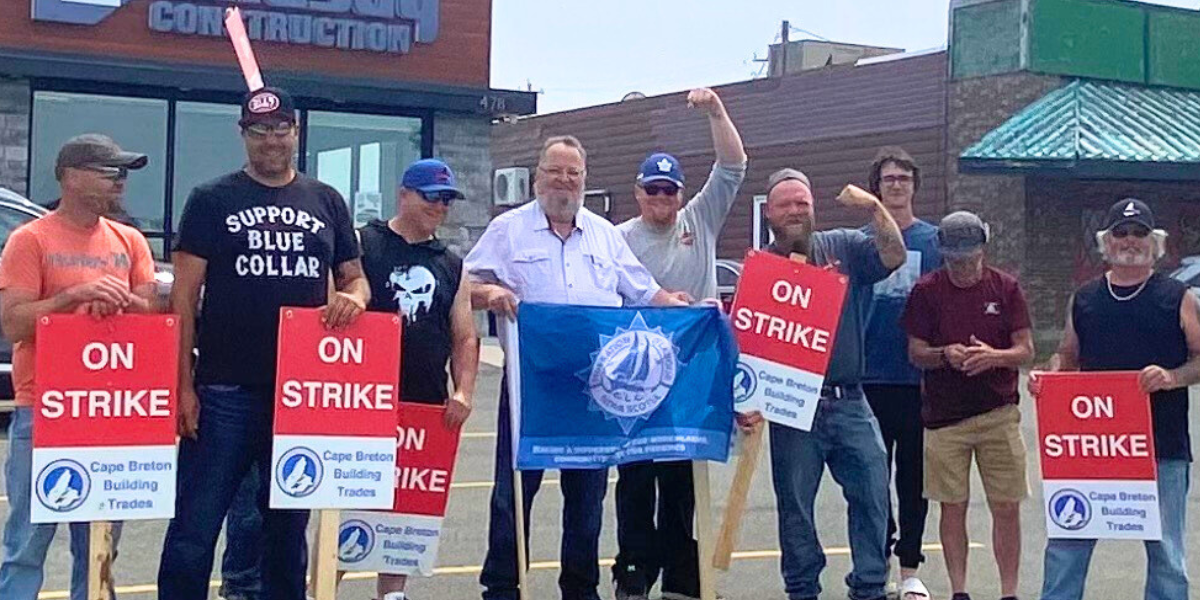Photo: Nova Scotia Federation of Labour
A tentative agreement was reached in the early morning of Monday July 21, 2025 between the affiliate unions of the Cape Breton Island Building & Construction Trades Council and construction companies throughout Cape Breton Island, ending the historic strike of over 4,000 construction trades workers who had withdrawn their labour from construction sites across the island.
The strike, the first of its kind in more than three decades, began on July 7, 2025, and involved ten of the fourteen unions affiliated with the Cape Breton Island Building & Construction Trades Council. Until the tentative agreement was reached, picket lines surrounded every major construction project site on Cape Breton Island, grinding all work to a halt at sites including the new Cape Breton University (CBU) medical campus building, hospital expansions, the Cape Breton Regional Municipality (CBRM) wastewater treatment plant in Glace Bay, the construction of a new “Dairy Queen” building near Glace Bay’s Sterling Mall, and the roundabout at Kings Road and Keltic Drive. .
Details of the tentative agreements are not yet available at this time. Workers have not yet ratified the agreement.
The strike had encompassed 11 unions as of July 10, 2025, after the Carpenters Union Local 1588 (which is not affiliated with the Building & Construction Trades Council) joined the action. The striking unions had included the International Brotherhood of Electrical Workers (IBEW) Local 1852, Labourers’ International Union of North America (LIUNA) Local 1115, various pipe trades, ironworkers, operating engineers, and other skilled trades. These workers are involved in approximately 95 percent of all commercial and industrial construction work in Cape Breton, giving them tremendous leverage in the current struggle.
The strike only involved construction workers in Cape Breton. Nova Scotia’s construction-sector unions are geographically divided between the unions on Cape Breton island, represented by the Cape Breton Island Building & Construction Trades Council, and those that are represented by the Mainland Nova Scotia Building Trades Council, which represents all other construction unions in the province. Affiliate unions on Nova Scotia’s mainland are currently engaged in active negotiations with the bargaining agent for the employers, the Nova Scotia Construction Labour Relations Association (NSCLRA), but the collective agreements of most major construction-sector unions in mainland Nova Scotia, including unions representing bricklayers, iIronworkers, insulators, electricians, and carpenters, do not expire until early 2026.
Bosses trying to keep pandemic concessions
The Cape Breton Island Building & Construction Trades Council emerged from the militant tradition of Cape Breton labour organizing. Founded in 1967, the Council was designed to provide coordinated bargaining power for multiple trades under one umbrella organization. This multi-trade approach was innovative for its time and reflected lessons learned from earlier struggles where employers could divide workers by playing one trade against another.
The catalyst for the Cape Breton strike during this summer’s construction season was the pandemic-era concessions made by the unions in their last collective agreement, signed in November 2020. At that time, in what was hailed as an “historic agreement” that would bring “labour stability to Cape Breton’s construction industry,” the unions made substantial wage concessions to keep critical infrastructure projects moving during the COVID-19 crisis.
These concessions were explicitly understood as temporary measures that would be remedied in future negotiations.
But as Council president Ernie Dalton explains, “These promises are not being honoured and current negotiations are once more asking our members to accept lower wages”.
The island’s construction bosses and employers, also represented by the Nova Scotia Construction Labour Relations Association, had offered what their president Robert Shepherd claimed was “a very fair offer”… “the highest that has been offered in Cape Breton in many, many, many decades, if not ever” prior to the unionized workers taking strike action in early July.
Workers decisively rejected this supposedly “generous” proposal in advance of the strike, suggesting that the real issue wasn’t the absolute level of wages but the fundamental question of who controls the terms of work and the distribution of wealth created by workers’ labour.
The strike occurred within a broader context of rising living costs and housing affordability crisis that has hit Cape Breton particularly hard due to the region’s relatively lower wages. Workers in all industries on the island are facing the squeeze between stagnant wages and rapidly rising costs for housing, food, and other necessities.
Strategic timing and economic impact
The timing of this strike demonstrated the workers’ sophisticated understanding of their strategic position within the capitalist economy. By walking off the job during prime summer construction season, they maximized their leverage over employers while minimizing the personal hardship typically associated with winter strikes.
As retired CBU professor Dr. David Johnson has noted, “the trades council is putting pressure on their employers at the most opportune time for the unions. This is a sound strategic move”.
The economic impact was immediate and substantial. Construction halted on all hospital sites, the new CBU medical campus, the CBRM wastewater treatment plant, new long-term care facilities in Dominion and New Waterford, and numerous other critical infrastructure projects when the strike began on July 7. Private construction companies across the island were also forced to suspend all operations.
This widespread shutdown revealed the fundamental dependence of Cape Breton’s economy on the skilled labour of these unionized trades workers. Every day the strike continued, it became clearer that the island’s economic development, from hospitals and schools to housing and commercial buildings, relies entirely on the willingness of these workers to sell their labour power.
Their collective withdrawal of that labour exposed the hollow nature of employer claims about “job creators” and “wealth generators” — it is the workers who create wealth, and their organized power that can bring capital accumulation to a grinding halt.
Construction industry profits
The strike also raised fundamental questions about the profitability of construction contractors and the distribution of wealth within the industry. While specific financial data on Cape Breton construction companies is limited, broader industry patterns suggest that contractors have maintained healthy profit margins even during periods when they’ve demanded wage concessions from workers.
The construction industry, particularly in small regional markets like Cape Breton, often operates with relatively thin profit margins on individual projects. However, this doesn’t necessarily translate to poor overall profitability for successful contractors. Many construction companies offset lower margins through high volume, strategic project selection, and various forms of cost externalization — including the suppression of wages and benefits.
What was particularly galling from the striking union members’ perspective is the asymmetric nature of economic risk in the industry. When economic conditions are difficult, contractors immediately demand wage concessions, benefit cuts, and other sacrifices from workers. But when conditions improve, as they clearly have in Cape Breton given the volume of major infrastructure projects underway, contractors are reluctant to restore previous concessions or share the benefits of improved business conditions.
The pandemic period provided a perfect example of this dynamic. Construction was deemed “essential” throughout COVID-19, allowing contractors to continue operating and bidding on major projects while workers faced health risks and made wage concessions to keep the industry afloat and moving. Now that the industry is booming with major hospital, university, and infrastructure projects, these same contractors claim they cannot afford to restore the concessions they demanded during the crisis and make the workers “whole.”
This pattern reflects a broader feature of capitalist employment relations: the socialization of risks and privatization of profits. Workers are expected to absorb economic shocks through wage cuts and benefit reductions, but they are not rewarded proportionally when business improves. The current strike represents a direct challenge to this arrangement.
Political support and class solidarity
The political response during the strike revealed interesting class dynamics within Cape Breton’s political landscape. Nova Scotia Federation of Labour President Danny Cavanagh has provided vocal support, joining workers on the picket line and declaring that “all of organized labour in Nova Scotia stands with them.. This solidarity from the broader labour movement reflected an understanding that the strike’s outcome will have implications far beyond Cape Breton’s construction industry.
Significantly, political figures from both the NDP and Liberal parties had expressed support for the striking workers. NDP MLA Kendra Coombes, no stranger to any picket line in the CBRM for many years, met with workers on picket lines on several days throughout the strike, emphasizing that “these workers want what all Nova Scotians want: to be able to take care of their families in the communities they love.” Sydney-Membertou Liberal MLA Derek Mombourquette posted video support, acknowledging the workers’ “dedication” and calling for both sides to return to the bargaining table, and Sydney—Glace Bay federal Liberal Member of Parliament Mike Kelloway was compelled to say that “Cape Breton’s tradesworkers deserve respect, fair wages, and safe working conditions. They’re the backbone of our schools, hospitals, roads, and homes — and they shouldn’t have to fight this hard for what’s right.”
This cross-party political support demonstrated that the workers’ demands have broad legitimacy even within mainstream political discourse, and reflect the broad community support that Cape Breton workers have traditionally enjoyed during labour struggles. This support stems partly from the island’s working-class culture, but also from recognition that construction workers’ wages and benefits set standards for the broader regional economy.
The more than 4,000 unionized construction workers in Cape Breton from each of the striking unions will have an opportunity to fully review and vote on the tentative agreement in coming days, and it remains to be seen if the terms and conditions of the tentative agreement will be enough to satisfy the legitimate and long-simmering frustrations of the island’s unionized construction workers.
Did you like this article? Help us produce more like it by donating $1, $2, or $5. Donate


